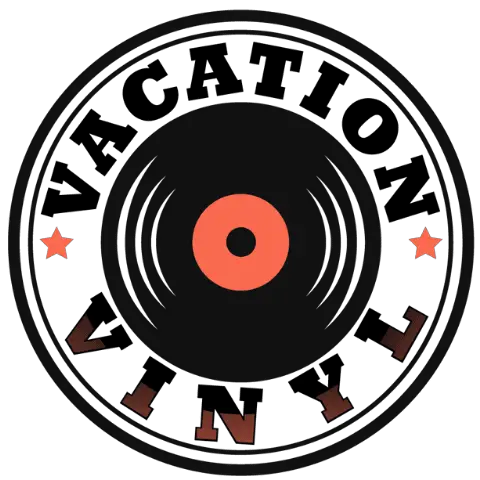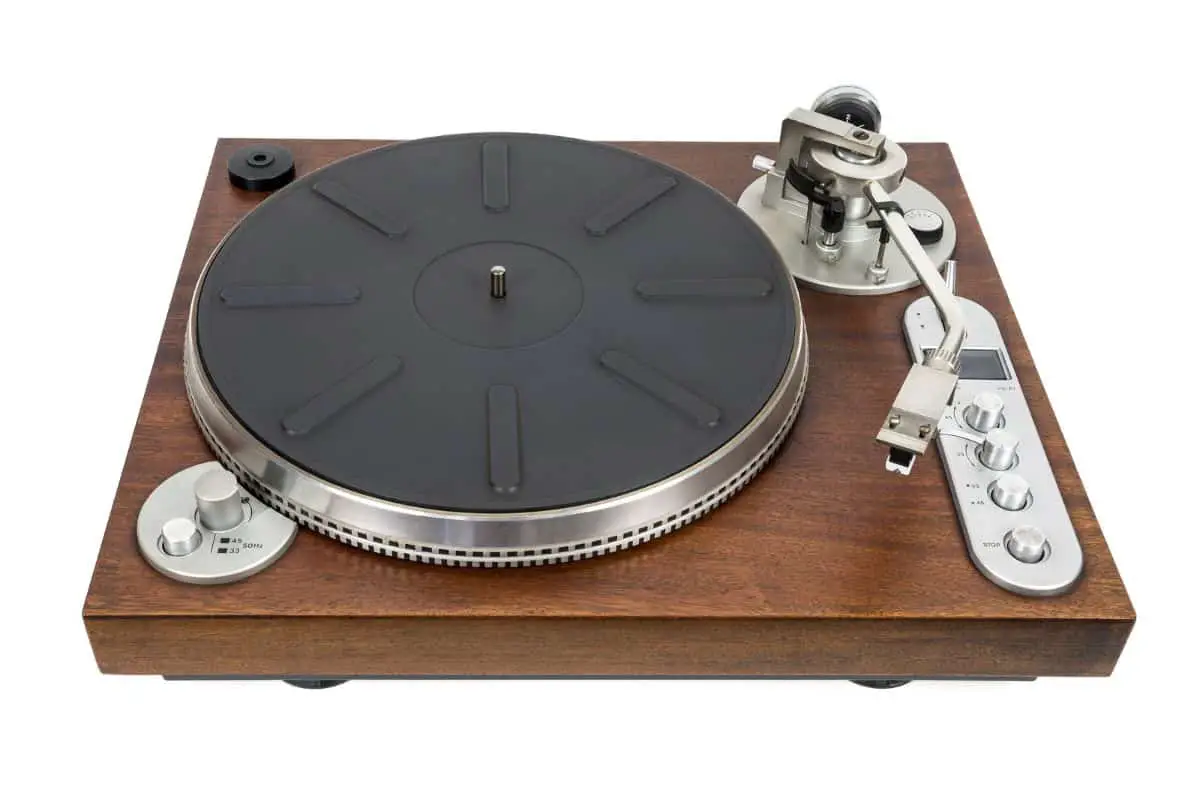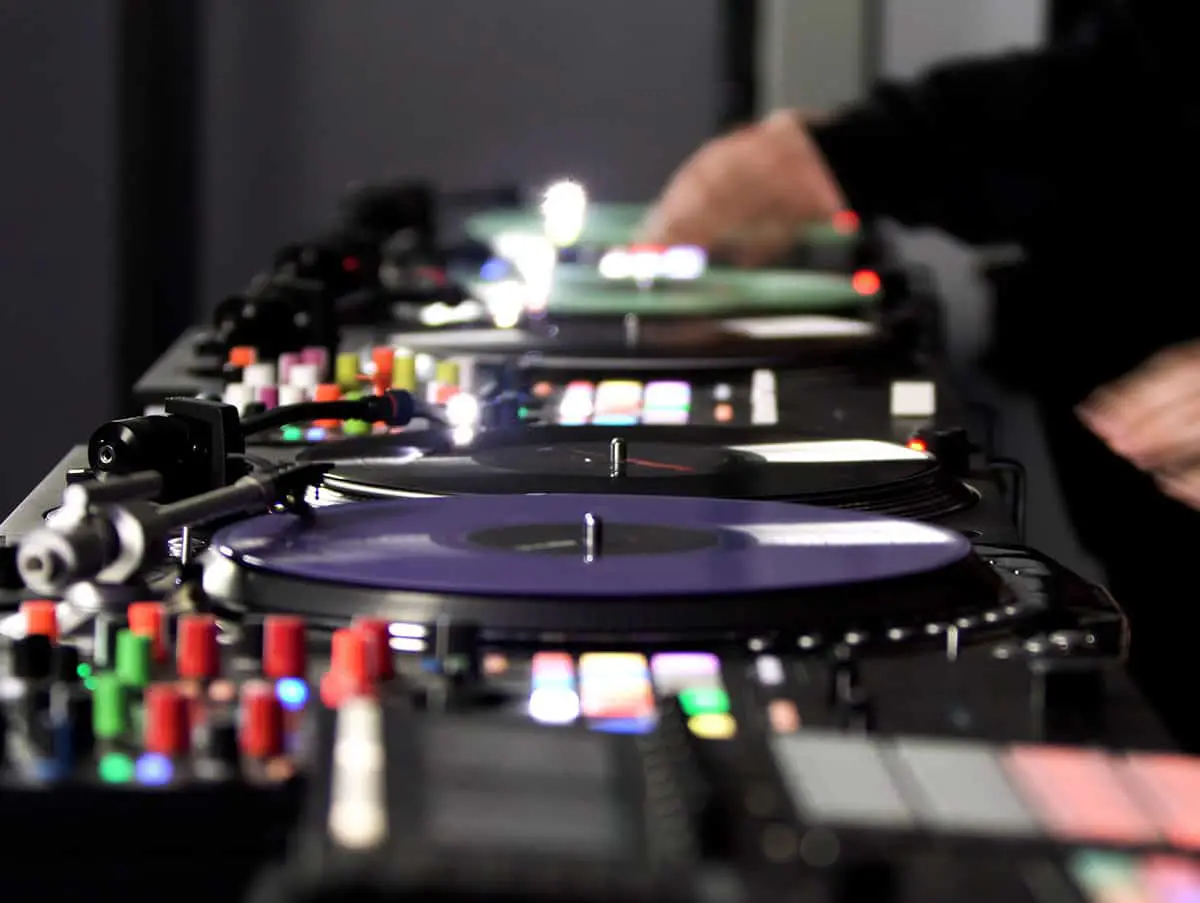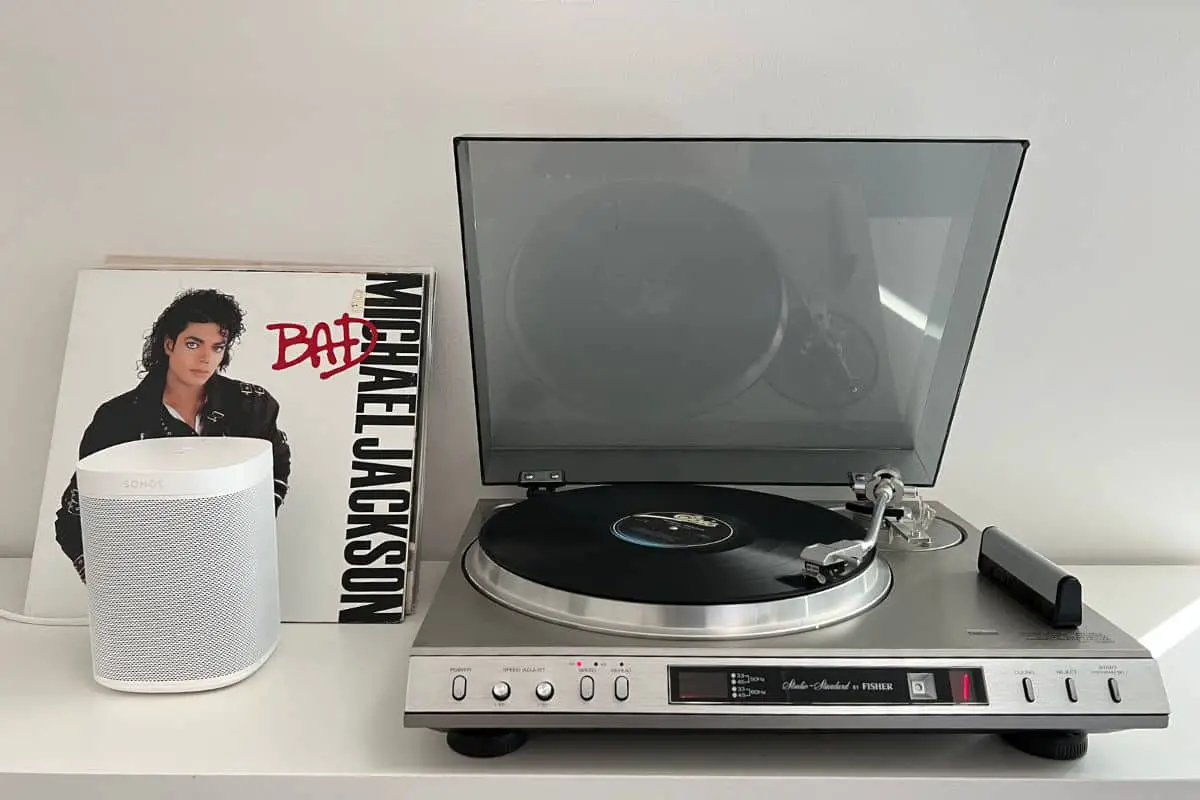This post contains affiliate links.
While you can place your speakers anywhere in the house and still enjoy your music, you can’t do the same with the turntable. After all, turntables function by measuring the vibrations, which can be affected by the vibrations produced by the speakers. (source) So if you want to know where to put your speaker and turntable, please read on…
The best place to position your turntable is away from any source of vibrations, and this means your speakers. As well, walking past a turntable can make it skip if not secure, so a secure location, isolated from the speaker vibration is best.
You may own the best speakers and turntable on the planet, but if they are not set up or positioned correctly, you won’t be able to get the best out of your system. So in this article, we’ll show you where to put your speakers and turntables. We will also show you the factors to consider when positioning your turntable and speakers.
Table of Contents
Does the Place Where You Put Your Turntable and Speakers Matter?
Generally, turntables function by measuring the vibrations. The vinyl record forces the stylus to vibrate or move in its grooves. The records player turns the vibrations into a minute electrical signal amplified and converted into sound by your speakers. Therefore, for the record player to work, it only needs to read the groove’s vibrations.
Unfortunately, the stylus is very sensitive and can even pick external vibrations. Therefore, it is a delicate operation, and external vibrations can affect the quality of your music. If the stylus is not getting a smooth ride, you won’t enjoy great music.
On the other hand, the speakers’ work is converting the electrical signal to sound, and for it to do its job, the speaker must vibrate. Basically, the turntable and the speakers produce music this way; therefore, you should always keep the speaker and the turntables apart.
You can keep a moderately-sized speaker on the same surface as the turntable with little to no issues. But the speaker should be well-made and not produce excess bass; plus, the surface must be solid. (source) Suppose you have a pair of powerful speakers. In that case, isolation is mandatory, especially if you don’t want the vibrations to affect the quality of your music.
Some speakers are cranked up enough to force the stylus to skip a bit, and at times they can cause acoustic feedback. This can be very scary for audiophiles, especially since the vibrations are picked by the stylus, creating a loop. (source) Therefore, placing the speakers and the turntables on the same surface or close proximity can hinder the record players’ ability to produce high-quality music.
Turntable Placement
Let’s begin with the vital component, the record player. After all, it is the most sensitive part of the setup. For the stylus to convert the vibrations from the vinyl to an electrical signal, it needs to be protected from external vibrations. Therefore, for you to enjoy exceptional music every day, you should follow the following advice:
Stability is Mandatory
Firstly, to prevent tracking problems, you should place the turntable on a heavy, flat, and stable surface. Placing the turntable on a flat, leveled surface and far from the speakers can help prevent tracking problems and lower tonearm friction. A sturdy and flat surface will make it possible for the turntable and the vinyl record to last longer. You can also enjoy high-quality music every day without worrying about vibrations and tracking issues if you place your turntable in the correct position.
The main reason you need a heavy and stable surface for the turntable is to lower the effects of vibrations and any other thing that can affect the quality of your music. If the right side is an inch lower than the left side, the tonearm and stylus will work extra hard when tracking the grooves on the vinyl records. Poor leveling can compromise channel balance, uneven wear and tear of the grooves, and slight distortion. (source)
Isolation
Isolation refers to getting rid of or reducing resonances or vibrations that can be easily picked up by the turntable’s stylus, cartridges, or tonearm. The vibrations that affect your record player can be categorized into three groups: self-generated, airborne, and structural. So make sure you address each of them independently when positioning your turntable and speakers.
Structural Isolation
Structural isolation refers to the sound waves that travel through the physical medium, including the surface where the turntable rests. Suppose your turntable is on a plastic surface with some speakers in close proximities. In that case, the lack of isolation can result in the stylus jumping out of the grooves. The vibration from the speakers can force the turntable to hum or rumble constantly. Luckily, there are many aftermarket solutions and creative DIY solutions for this problem. (source)
Airborne Vibration
The airborne vibration incorporates the airborne sound waves from the speakers that can create resonance or vibrations in the stylus/cantilever point, turntable, tonearm, and the circuit board. These issues typically present as mild distortions, which can be very annoying to audiophiles.
Therefore, the main factors to consider when dealing with airborne vibrations are turntable and speaker placement. Moving the speakers or turntables away from each other can reduce the feedback they can generate and airborne vibrations. (source)
Self-Generated Vibrations
The self-generated vibrations can be triggered by the belt or turntable itself. Luckily, some turntables like the Technics SL-1200 have a magnetic motor; therefore, you’ll never have to worry about high self-generated vibrations. The design of the SL-1200, it’s unique dampening, and high-torque motor with low flutter and wow levels are what made this brand the best option in the industry. (source)
Where to Position the Turntable?
As aforementioned, the best position for your turntable should be perfectly leveled, have low resonance, and be as far from your speakers as possible. If your home has a concrete floor, a floor standing support can come in handy. Unfortunately, a floor standing support can cause footfall on suspended wooden floors. So, if you have a suspended wooden floor, you need to install a dedicated wall shelf. (source)
A dedicated wall shelf can help you prevent footfall problems, so try and use some heavy-duty fixings and mounting screws. Unfortunately, they can be pretty costly, but they are worth the investment. These decks have some unique built-in isolation, with the simplest form of support being rubber feet. For some turntables, you can go for a fully suspended shelf design. (source)
Therefore, the more isolated the turntable is, the less fussy your stand should be. In fact, the best designs will function better with exceptional support and careful placement. After identifying the best position for your turntable, the next step is ensuring that it is leveled.
The stand or shelves should always be leveled; after all, this is the only way you can ensure that the stylus tracks the vinyl’s grooves correctly. You can even confirm if the shelves are leveled using a light, trim spirit level.
You should begin with the pedestal, but you shouldn’t have a lot of work if the stand is leveled. But if you need to make some adjustments, then some adjustable turntables feet can help you get everything leveled.
Next, confirm if the platter is leveled; luckily, most turntables’ platters are positioned relative to the stand. Therefore, they should be parallel from the start unless there is an issue from the factory. A suspended shelf design will make it possible for you to achieve some degree of adjustment. Usually, the leveling is done in its original position; however, some decks will require a specialized jig, so you may have to take it to the dealer.
Speaker Placement
After placing the turntable in the right place, the next thing you should consider is speaker placement. And with vibration from the speakers being a problem with turntables, the place where you position your speakers is essential. Therefore, you should ensure that the record player and the speakers never interact. Here are some of the things you have to consider when looking for the right place for your speakers include:
Bad Vibrations
One of the leading issues with turntables and speakers is their vibrations. Generally, the turntable works by reading the minuscule variations of the grooves of the vinyl records. And for it to do its work perfectly, it needs to be still and not affected by the external sources of vibrations like the one produced by speakers playing bass frequencies.
Where Can You Put Your Wireless Turntable?
You can move it from one place to another with a wireless turntable. Luckily, most turntables like Yamaha MusicCast Vinyl 500 use Wi-Fi to signal the speaker. Therefore, with a wireless turntable, you have an option. Still, some of the best places for putting a wireless turntable include:
- Reading Nook
- The home office
- Enclosed patio
- Bedroom
- Dining room/ kitchen
- Near your home bar
- Game room (source)
Securing the Speakers

If you place the speakers on the same shelf or near the record player, the vibrations will affect the quality of your music. Therefore, you should put your speakers on wall brackets or stands and the turntable as far away from the speakers as possible. (source) You should never put them on the same surface.
Therefore, if you own some bookcase speakers, you should use speaker stands to help isolate the vibrations. The floor-standing speakers are designed to sit on the floors. Still, you need to consider the connection between your speakers and the floor when using them with your turntable.
What Should I Place Between the Speaker and the Stand to Minimize Vibrations?
There has been an issue with floor standing speakers and stands between the floor and the speakers. And for the longest time, most folks have used spikes to nail their speakers to the stand and floors. In fact, some speakers come with spikes that can help you attach them to the floor to limit vibrations.
But some folks have discovered that nailing the speakers to the floor negatively affects the sound quality. These folks claim that the best solution is isolating the speakers from the stand using some soft rubber or foam pads. Remember, the bigger the speakers, the larger the effects of isolation. Luckily, all speakers sound more open and better when isolated. (source)
The speaker stands come in a wide range of sizes, types, and materials, with wood and metal being the famous options. Luckily, each material has the unique character that it adds to the quality of the sound it produces. But when it comes to the stand, the general rule stipulates that the heavier the material used to make a stand, the more rich and solid the sound.
Therefore, if you need a controlled and tightly focused sound, you should place your speakers on a heavy metal stand. You can also go for a fast and open sound if you use a lighter stand. The interface between the stand and the speakers is crucial. If you place a sponge pad between the stand and speakers, you will get a better balance. (source)
Therefore, you should get your speakers off the shelves or behind the sofa and look for a better position for them. If you find an exceptional place that won’t affect your turntable, you will notice the difference.
Speaker Positioning
The position of your speakers is crucial as it can play a pivotal role in the quality of your setup’s sound. The speakers should be at a listening height. If you’re on the sofa, then the placement height of the speakers should be determined by the height of your ears when seated. Placing the speakers near the back walls will give you more bass, while setting them far away will offer you convincing stereo imaging. (source)
Even though it may be convenient, you should avoid placing the speakers in the corners. Putting them in the corner will give you a lumpy, fat bass that will affect the quality of the music produced by turntables. Imaging can also be affected by the speaker’s angle. In fact, most speakers sound perfect when toed-in towards the most common listening position in your home. (source)
For peak sound dispersion, all speakers should be at an equal distance to your favorite listening position. So here are a few factors to consider when positioning your speakers:
- Room length: if the room where you usually sit when listening to music is rectangular, the speakers should face the room’s length. Therefore, you should place the speakers on the shortest walls in the room.
- Think about the room in thirds: start by dividing the room’s length by three and place your speakers in the first third and about a meter from the side walls.
- The speaker angles: the sound of the music is spread between your speakers. If you have two speakers, positioning them at a 60-degree angle will create an exceptional stereo angle. So you should measure the angle ideally using a protractor. Simply place a marker on your listening position and start from there.
- The space between the walls and the speakers: if you’re working with a huge room, you can leave a zone of about 2.2 meters between the walls and the speakers. After all, placing them near the wall will result in the speakers producing bass, which may cause too much vibration and end up affecting your turntable.
- Place the sub-woofers about 30 cm from the corners: Subwoofers should never be placed in the corners; instead, they should be about 30 cm from the corner.
- Speaker height: the speaker should always be leveled with your head, so if you love listening to the music when seated, it should be leveled with your head when seated or about 1.2m high. The tiny speaker cones, also referred to as tweezers, are responsible for the high-quality sound produced by the turntable. The sound from the tweezers always travels in a straight line. So they should point directly to your ears.
- Place desktop speakers on foam: if you’re using some desk speakers, you should place them on a foam pad. The foam will prevent the desk from becoming a bass speaker. (source)
- The center channel of the surround sound system should be in front of you: the center channel must always be in front of you with your side speakers at about 110-degrees to the side. The speakers should be at a 60-degrees angle from you.
FAQs
How Far Should Your Speakers Be From the Turntable?
Speakers are known for producing vibrations that can affect your listening experience, so you should ensure that they are far apart. Therefore, the distance between the turntable and the speakers should be at least 2 meters.
Where Can I Place My Speakers?
Walls reflect sound and vibrations; plus, speakers have a rear-facing bass port. Therefore, the speakers should be at least 3 feet from the walls.
How High Should Your Speakers Be Off the Floor?
The best place for the center speakers is at your ear level when seated on the sofa. The right height is usually between 30 and 50 feet from the floor. If you can lift the center speaker, you should tilt it, making sure it fires directly into your ears.
Conclusion
There is nothing more relaxing and fun than listening to a vinyl record of your favorite. Unfortunately, any form of vibration can affect the quality of your music, including the speakers’ vibrations. Therefore, the speakers and the turntable should be as far away from each other as possible.
Sources
- Ketan Bharadia, How to get the best sound from your turntable, Accessed January 02, 2022
- Jeffrey Lee Puckett, The importance of isolation and how to fix vibration in your turntable setup, Accessed January 02, 2022
- RA Pro staff, a guide to troubleshooting turntables, Accessed January 02, 2022
- Jason Kennedy, Speaker Placement: A step-by-step guide, Accessed January 02, 2022
- Andrew Murphy, How to set up and position your speaker, Accessed January 02, 2022
- Tom Davenport, How to position your speakers perfectly, Accessed January 02, 2022
- Mac Randall, Seven Fun Places to Put Your Wireless, Accessed January 02, 2022
VacationVinyl.com is a participant in the Amazon Services LLC Associates Program, an affiliate advertising program designed to provide a means for sites to earn advertising fees by advertising and linking to Amazon.com. We also participate in other affiliate programs which compensate us for referring traffic.




